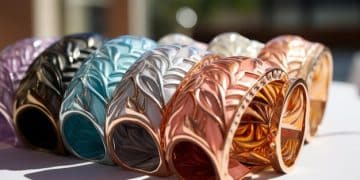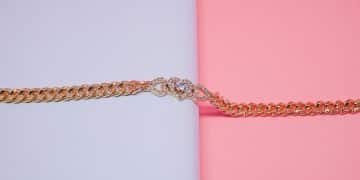Fashion Jewelry Metals to Avoid in 2025: Protect Your Skin and Your Investment

Exploring Fashion Jewelry Metals helps you make smarter style choices — especially when health and durability matter. In 2025, not all pieces deliver the shine they promise. While fashion jewelry offers affordability and creativity, some materials can irritate your skin, tarnish quickly, and lose value far too fast.
This guide highlights which metals to avoid and how to choose safer alternatives, so your accessories elevate your look without compromising comfort.
The Perils of Nickel Alloys in Fashion Jewelry
Nickel continues to be one of the most common culprits behind adverse reactions to fashion jewelry. Its low cost and malleability make it a popular choice for alloying with other metals, enhancing durability and luster.
However, a significant portion of the population suffers from nickel allergy, a contact dermatitis that manifests as redness, itching, swelling, and even blistering upon prolonged skin contact.
While awareness of nickel allergy has grown, it remains prevalent in costume jewelry, often hidden in alloys not explicitly labeled.
Consumers should be particularly wary of “mystery metals” or pieces that feel unusually light and cheap, as these often contain a high percentage of nickel.
Understanding Nickel Sensitivity
Nickel sensitivity is an immune response, not a true allergy, though commonly referred to as such. It develops after repeated exposure and can become a lifelong condition. The reaction occurs when the nickel salts on the surface of the jewelry react with sweat, forming ions that are absorbed by the skin and trigger an inflammatory response.
- Common Symptoms: Itching, redness, rash, dry patches, and blistering at the contact site.
- Prevalence: Affects approximately 10-20% of the population, with higher incidence among women.
- Long-Term Effects: Chronic exposure can lead to thickening and darkening of the skin, and persistent discomfort.
Regulatory Landscape and Gaps
While regions like the European Union have strict regulations regarding nickel release rates in jewelry, the United States does not have a comprehensive federal standard.
This disparity means that jewelry imported from countries with lax regulations, or even domestically produced items, may still contain high levels of nickel.
This lack of uniformity makes it challenging for consumers to confidently purchase nickel-free items without explicit labeling or testing.
For 2025, it is advisable to prioritize brands and retailers that explicitly state their jewelry is nickel-free or hypoallergenic. Always check product descriptions and, if possible, inquire about the metal composition before purchasing.
The Dangers of Lead and Cadmium in Affordable Jewelry
Beyond skin irritation, some fashion jewelry contains far more insidious elements: lead and cadmium.
These heavy metals are highly toxic and, shockingly, still find their way into mass-produced jewelry despite their well-documented health risks.
Lead, in particular, has been a problem in children’s jewelry for years, leading to severe health complications, but its presence in adult fashion jewelry often goes unnoticed.
Cadmium, similar to lead, can cause a range of health issues from kidney damage to bone weakening, and is even classified as a human carcinogen.
Both metals are favored in low-cost manufacturing for their ease of use in casting and their ability to add weight and shine to inexpensive alloys, sometimes even used as replacements for more expensive silver or gold plating.
Health Implications of Lead and Cadmium Exposure
The risks associated with lead and cadmium exposure from jewelry are primarily through skin absorption, ingestion (especially if jewelry is handled and then hands come into contact with the mouth), or even inhalation of dust particles from deteriorating pieces.
Children are particularly vulnerable due to their smaller body mass and hand-to-mouth behaviors.
- Lead: Can affect neurological development in children, cause reproductive issues, kidney damage, and anemia in adults.
- Cadmium: Linked to kidney dysfunction, bone demineralization, and a heightened risk of certain cancers.
- Accumulation: Both metals accumulate in the body over time, meaning even small, repeated exposures can lead to significant health problems.
Identifying and Avoiding Contaminated Jewelry
It’s incredibly difficult for consumers to identify lead or cadmium in jewelry without specialized testing.
These metals do not have a distinct smell or appearance. The best defense is to be skeptical of extremely low-priced items, especially those with an unusually heavy feel for their size, or a dull, grayish appearance under a shiny coating.
Demand transparency from retailers and stick to reputable brands committed to safe practices.
In 2025, consumer advocacy groups and stricter import controls might play a larger role, but individual vigilance remains paramount.
Always prioritize safety over fleeting trends, especially when dealing with items that will be in direct contact with your skin.
The Problem with Low-Quality Plating: Brass and Copper Bases
Many fashion jewelry pieces rely on a thin layer of precious metal (like gold or silver) plated over a base metal.
While this offers the aesthetic appeal of fine jewelry at a fraction of the cost, the longevity and safety heavily depend on the quality of the plating and the base metal used.
Brass and copper are common base metals, chosen for their affordability and workability.
The primary issue arises when the plating is too thin or poorly applied. It quickly wears off, exposing the underlying brass or copper.
These metals readily oxidize when exposed to air, moisture, and skin oils, leading to tarnishing and a green or black discoloration of the skin. This green stain is not harmful but can be unsightly and difficult to remove.
Understanding Skin Discoloration
The greening effect is a chemical reaction. Copper, a primary component of brass, reacts with the oxygen in the air, sweat, and other chemicals (like lotions or perfumes) on your skin.
This creates copper carbonate, a blue-green compound, which transfers to your skin, leaving a temporary stain.
Challenges with Poor Plating Quality
- Rapid Tarnishing: Exposed brass and copper will quickly tarnish, losing their shine and appealing color.
- Skin Discoloration: The characteristic green stain on the skin, particularly noticeable on fingers or wrists.
- Allergic Reactions: While less common than nickel, some individuals can react to copper, experiencing similar symptoms of contact dermatitis. Brass, being an alloy of copper and zinc, can also trigger reactions.
For 2025, look for fashion jewelry with thicker plating (e.g., vermeil, which is sterling silver plated with a thick layer of gold) or those explicitly stating multi-layer plating processes.
Better quality plating means less chance of the base metal being exposed and causing issues. Researching brand reputation for plating durability is also a wise move.

Steering Clear of Unknown Alloys: The “Mystery Metal” Trap
One of the trickiest categories of fashion jewelry to navigate is that made from “mystery metals” or “metal alloys” without specific disclosure of their components.
This lack of transparency is a red flag, as these pieces are often a blend of whatever inexpensive metals or scraps are available to manufacturers, including potentially harmful elements like nickel, lead, or cadmium.
The term “alloy” simply means a mixture of two or more metals. While fine jewelry also uses alloys (e.g., 14K gold is a gold alloy), reputable manufacturers always disclose the composition.
In fashion jewelry, an undisclosed alloy is almost always a sign of cutting corners on material costs and, potentially, safety.
Risks Associated with Undisclosed Alloys
- Hidden Allergens: The most significant risk is the presence of common allergens like nickel, leading to unexpected skin reactions.
- Toxic Additives: Lead and cadmium can also be lurking within these anonymous blends, posing serious health risks upon prolonged contact or ingestion.
- Rapid Degradation: Unknown alloys often lack the stability of purer metals or well-defined mixtures, leading to quick tarnishing, rusting, or structural breakdown.
The Importance of Ingredient Transparency
In 2025, a growing trend in consumer products, including fashion, is transparency. Savvy shoppers are increasingly demanding to know what goes into the items they purchase.
When shopping for fashion jewelry, if the material is simply listed as “metal alloy” or “mixed metals” without further detail, it’s wise to exercise caution.
Opt for pieces where the seller explicitly details the composition, even if it’s an inexpensive base metal, as this indicates a level of accountability.
Some brands are now proactively advertising “hypoallergenic,” “nickel-free,” or “lead-free” materials, or even specifying base metals like stainless steel or sterling silver with specific plating.
These are generally safer bets than the ambiguous “mystery” alloys.
The Environmental Impact and Ethical Concerns of Certain Metals
While the primary focus is often on personal health and investment, it’s equally important to consider the broader implications of the materials in our fashion jewelry.
The mining and processing of certain metals can have significant environmental and social costs. In 2025, an increasing number of consumers are prioritizing ethical sourcing and sustainability in their purchases.
Some cheap fashion jewelry contains metals extracted through methods that contribute to deforestation, water pollution, and unethical labor practices.
While it’s challenging for the average consumer to trace the origin of every component in an inexpensive piece of jewelry, being aware of the general practices can guide more responsible choices.
Environmental Degradation from Mining
Conventional mining of base metals can be highly destructive to ecosystems. It often involves:
- Habitat Destruction: Clearing land for mines and infrastructure.
- Water Contamination: Release of toxic chemicals like cyanide and mercury into water sources.
- Air Pollution: Emissions from smelting and processing facilities.
Ethical Labor and Supply Chain: A Hidden Cost
The cheaper a piece of jewelry, the more likely its production chain has been optimized for cost efficiency above all else.
This can unfortunately mean disregard for fair wages, safe working conditions, and environmental protection in the countries where these base metals are mined and processed.
For those looking to align their fashion choices with their values in 2025, consider brands that emphasize:
- Recycled Metals: Utilizing recycled brass, copper, or other base metals reduces the need for new mining.
- Certifications: Though rare for fashion jewelry, some larger brands might have certifications for responsible sourcing.
- Transparency Reports: Brands that openly share information about their supply chain and environmental efforts.
Awareness, even if it doesn’t lead to immediate purchasing changes, fosters a more conscious consumer culture that can ultimately push the industry towards more sustainable and ethical practices.

Choosing Safer Alternatives for Your Fashion Jewelry
Given the array of metals to avoid, what are the safer and more durable alternatives available in the fashion jewelry market for 2025?
Thankfully, manufacturers are increasingly offering a variety of options that minimize health risks, resist tarnishing, and provide better value for money. Making informed choices can significantly enhance your jewelry wearing experience.
When selecting fashion jewelry, consider these safer and more reliable metal options. These choices not only protect your skin but also ensure that your investment in style lasts longer and looks better over time.
They represent a blend of affordability with improved quality and safety standards.
Hypoallergenic and Durable Options
- Stainless Steel: Highly durable, tarnish-resistant, and generally hypoallergenic. Used widely for its strength and low maintenance.
- Titanium: Extremely lightweight, strong, and highly biocompatible, making it excellent for sensitive skin. Often used in body jewelry.
- Sterling Silver (with caveats): While not strictly a “fashion” jewelry metal in the cheapest sense, it’s widely available. It’s safe, but does tarnish. Look for rhodium-plated sterling silver to prevent tarnishing and enhance shine.
- Gold-Filled Jewelry: A much thicker layer of gold mechanically bonded to a base metal (often brass). It’s more durable and tarnish-resistant than simple gold plating, and a good bridge between fashion and fine jewelry.
- Rhodium Plating: Often used on white gold and sterling silver, rhodium plating provides a bright, shiny, and tarnish-resistant finish. It’s a noble metal and generally hypoallergenic.
Tips for Smart Shopping in 2025
To ensure you’re choosing the best fashion jewelry, adopt these practices:
- Read Descriptions Carefully: Always look for explicit mentions of “nickel-free,” “lead-free,” “hypoallergenic,” or specific metal compositions like stainless steel or titanium.
- Shop Reputable Retailers: Purchase from established brands and stores known for quality and transparency rather than unverified online sellers.
- Perform a Patch Test (if unsure): If you’re particularly sensitive, wear a new piece for a short period on a less visible area of skin to check for a reaction.
- Prioritize Quality Over Quantity: A few well-made, safe pieces will serve you better and longer than a multitude of cheap, potentially harmful ones.
By being a discerning consumer, you can safeguard your health and enjoy your fashion jewelry collection without worry. In 2025, the trend is towards conscious consumption, and choosing safer metals is a significant part of that movement.
Key PointBrief Description
🚫 Nickel AvoidanceKnown allergen causing dermatitis; prevalent if not explicitly labeled nickel-free.
☣️ Lead & Cadmium DangersToxic heavy metals posing serious long-term health risks; difficult to detect.
👎 Poor Plating IssuesThin plating over brass/copper leads to tarnishing and skin discoloration.
✅ Safe AlternativesOpt for stainless steel, titanium, rhodium-plated, or gold-filled jewelry.
Frequently Asked Questions About Fashion Jewelry Metals
The most common problematic metals are nickel, known for causing allergic skin reactions, and toxic heavy metals like lead and cadmium, which pose serious health risks. Additionally, poorly plated base metals like brass and copper can lead to skin discoloration and rapid tarnishing, diminishing the jewelry’s appearance and value over time.
It’s challenging to identify these metals without specific testing, as they often don’t have a distinct look or smell. The best approach is to check product labels for explicit “nickel-free,” “lead-free,” or “hypoallergenic” claims. Be wary of very inexpensive items or those generically labeled “metal alloy” without further detail from reputable sellers.
Lead exposure can lead to developmental issues in children, reproductive problems, kidney damage, and anemia in adults. Cadmium is linked to kidney dysfunction, bone weakening, and is classified as a human carcinogen. Both metals accumulate in the body, making repeated exposure dangerous even at low levels, thus posing serious long-term health concerns.
Skin turning green from jewelry is typically caused by copper, a common component in brass, which is often used as a base metal for plated jewelry. The copper reacts with oxygen in the air, sweat, and chemicals like lotions or perfumes on your skin, forming a greenish compound that transfers to your skin. It’s harmless but unsightly.
Excellent alternatives include stainless steel (highly durable and hypoallergenic), titanium (lightweight and biocompatible), and gold-filled jewelry (a thicker gold layer for longevity). Rhodium-plated pieces, often sterling silver, offer tarnish resistance. Always look for explicit labeling from brands committed to using safer and higher-quality materials for peace of mind.
Conclusion
Choosing Fashion Jewelry Metals wisely is essential for both style and well-being in 2025. Avoiding risky materials such as nickel, lead, cadmium, and poorly plated brass or copper helps prevent irritation and premature wear.
Opting for stainless steel, titanium, gold-filled, and rhodium-plated pieces offers a safer, longer-lasting alternative.
For more insight into hypoallergenic materials and trusted options, explore this helpful reference — an artisan-curated guide to safer metals and what to avoid in 2025.
Making informed metal choices helps protect your skin, safeguard your investment, and enjoy jewelry that lasts.
Liked the article?





